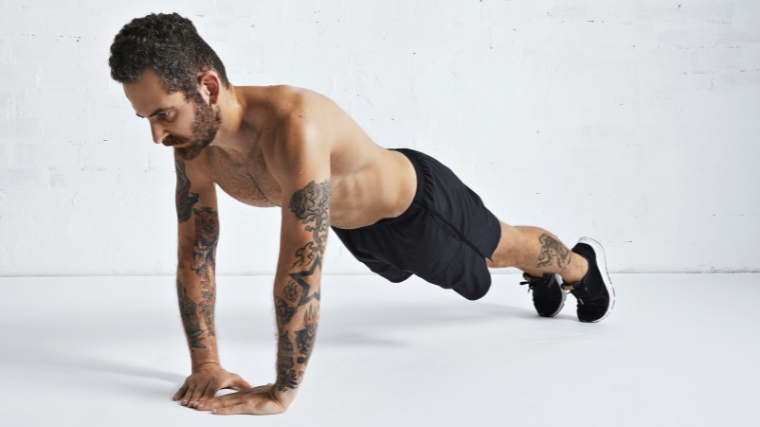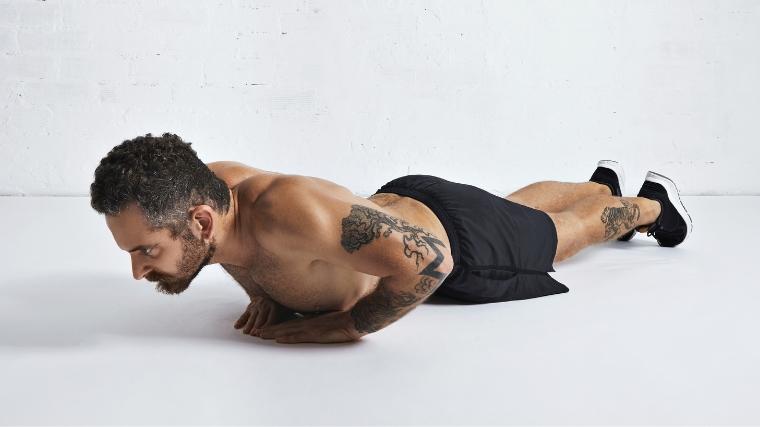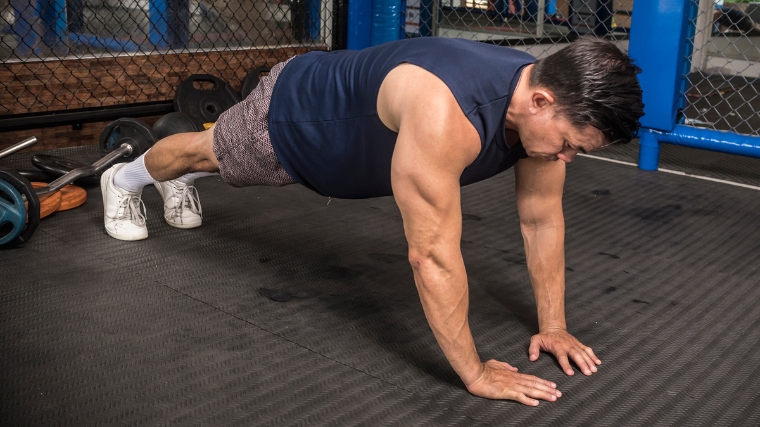The diamond push-up is a very popular variation — and not just because its name suggests riches in gains. It may be a basic calisthenics exercise on the surface, but chip away at it and you’ll see that it’s an incredible asset for increasing muscle mass in your chest, shoulders, and triceps.

If you’re executing this exercise appropriately, you’ll find that it is not just a beginner exercise. In fact, it can be extremely difficult to master. But it will be well worth it. Here, you’ll find out everything you need to know about how to perform the diamond push-up, how you should integrate it within your training, and why you should.
- How to Do the Diamond Push-Up
- Diamond Push-Up Sets and Reps
- Common Diamond Push-Up Mistakes
- Diamond Push-Up Variations
- Diamond Push-Up Alternatives
- Muscles Worked by the Diamond Push-Up
- Benefits of the Diamond Push-Up
- Who Should Do the Diamond Push-Up
- Frequently Asked Questions
Editor’s Note: The content on BarBend is meant to be informative in nature, but it should not be taken as medical advice. When starting a new training regimen and/or diet, it is always a good idea to consult with a trusted medical professional. We are not a medical resource. The opinions and articles on this site are not intended for use as diagnosis, prevention, and/or treatment of health problems. They are not substitutes for consulting a qualified medical professional.
How to Do the Diamond Push-Up
Even though most strength athletes have done push-ups before, proper push-up form is notoriously tricky. Add a close-grip element, and it gets even harder. The devil’s in the details — or in this case, your hand position.
Step 1 — Set Your Start Position

Roll out an exercise mat or yoga mat. While facing down, place your feet together about hip-width apart. Position your hands close together with open fingers. Use your thumbs and first fingers to form a diamond shape.
Make sure that your hands are below your upper chest with straight elbows. Assume a neutral spine with a braced core. Make sure your torso and legs are rigid.
Coach’s Tip: You may find it helpful to slightly unlock your knees if you tend to overextend your lower back.
Step 2 — Lower Yourself To The Ground

Initiate the eccentric portion of the diamond push-up by lowering your chest toward your hands. Inhale as you go down. Keep your elbows tucked close to your torso. Make sure your posture remains rigid when you lower yourself. Do not allow your lower back and hips to flop down or arch up.
Coach’s Tip: It is important to allow your shoulder blades to pinch back as you lower yourself to the ground. Otherwise, you may find your shoulders rolling forward, which may cause joint discomfort.
Step 3 — Press Yourself Back Up

Exhale as you forcefully push yourself back up. Keep your torso and posture rigid as you push up so that your whole body comes up as one whole unit.
Coach’s Tip: Allow your shoulder blades to fully protract, as this activates your serratus anterior. Cue yourself to reach your upper back towards the ceiling at the top of the push.
Diamond Push-Up Sets and Reps
As a bodyweight exercise, this is an extremely versatile move that can help you achieve any number of goals. Understanding what you want to achieve will determine how you incorporate this move in your routine.
- For Building Muscle Mass: If you want to build muscle mass, aim for three to four sets of eight to 10 reps if eight to 10 reps is hard for you. If you can perform more than 15 reps of diamond push-ups in one set, aim for three to four sets of as many reps as possible, stopping one to two reps short of failure.
- For Beginners: As a beginner, you need to focus on technique. As a result, you should avoid training close to failure. Instead, concentrate on accumulating multiple reps over several sets. Aim for three to four sets of five to 10 clean reps.
- For Explosive Strength: If you want to build explosive strength for sports such as boxing, aim for three to four sets of four to six reps. Perform these reps as explosively as possible with the intent to push yourself off the ground if possible.
You can program your sets as part of your warm-up or finisher if you’re advanced at this movement. If you’re just learning, it can be a main strength component of your bodyweight workout.
Common Diamond Push-Up Mistakes
Just because the diamond push-up is a simple exercise does not mean it’s impossible to get wrong. Making certain types of mistakes can cause you discomfort and make this move less effective at targeting certain muscle groups.
Overextending Your Lower Back
If you allow your lower back to slouch toward the floor and overextend, this can influence your shoulder movement during the exercise. When your lower back and hips sag toward the ground, it will make it harder for your shoulder blades to protract when you push up.
When you find yourself doing this, allow a subtle bend in your knees and bring your hips closer to the sky. This will help you keep your back a bit flatter. You may also find it useful to engage your abdominals and glutes.
Not Keeping Your Body Rigid
You’ll want to keep your body rigid during diamond push-ups. If your hips and legs aren’t in line with the rest of your body, they may lower to the ground sooner than your chest. This is one sure way to reduce your range of motion and reduce the stimulus for your chest, shoulder, and triceps muscles.

One solution that can help you with this is to position yourself by the wall and press your heels against the bottom of the wall. This will encourage you to keep your hips and legs a bit more stiff and rigid when you perform the diamond push-up.
Not Allowing Your Shoulder Blades To Freely Move
You need to allow your shoulder blades to move freely to maximize how much you activate certain key muscle groups — like your pectoralis minor and serratus anterior — for shoulder health and maximum gains.

When you descend, think about pinching your shoulders together behind you. Then, when you ascend, allow yourself to round your shoulders forward toward the ground.
Diamond Push-Up Variations
The diamond push-up itself may not fully satisfy your needs in the gym. When you get to a point where you’d like to progress the movement, here are some diamond push-up variations you may want to consider.
Isometric Diamond Push-Up
Perform the isometric diamond push-up by holding yourself statically at the bottom of the range of motion for a given period of time. The benefit of this variation is that you get to spend more time under tension at the hardest point of the push-up.
You can attempt to do this for sets until you reach failure. Alternatively, you can pre-determine the amount of time you want to spend in each set.
Weighted Diamond Push-Up
Once you get very experienced with diamond push-ups, you may hit a point where you can perform more than 20 repetitions without any trouble. At this point, in order to make the exercise more effective at increasing muscle mass and strength, you may want to increase the resistance.
A good way of doing this is loading it up with a weight plate on your back. Adding weight to your diamond push-ups will be a more time efficient way of training your muscle fibers hard without spending time performing a very high number of repetitions.
Banded Diamond Push-Up
If you want to develop explosive strength with diamond push-ups, consider the banded diamond push-ups. This variation is performed with a resistance band wrapped around your upper back and held onto the floor with your hands.
This majorly increases the resistance as you push up higher up. As a consequence, it also forces you to push up more explosively.
Diamond Push-Up Alternatives
The diamond push-up is often used as a variation to activate the triceps more. After a while, you may plateau and need a different alternative to progressively overload the key muscle groups. Here are some alternatives you may want to consider.
Close-Grip Bench Press
The close-grip bench press is a barbell alternative movement that can replicate the movement you perform with the diamond push-ups. The advantage of the close-grip bench press is that you can measure the load you are using. With the close-grip push up, it is not immediately obvious how much tension is going through your arms.
Also with the close-grip bench press, you can make progressions in the resistance easily by manipulating how much you load the barbell. You can even overload your triceps with even more weight than you can with a push-up.
Dip
The dip is a more advanced calisthenics alternative than the diamond push-up. With the dip, the only point of contact is your hands. However, your feet are on the ground with diamond push-ups. The dip can activate the same muscle groups in a slightly different movement pattern.
You can perform dips with assistance with an assisted dip machine or resistance bands. Alternatively, you can up the intensity by stringing a weight plate onto a dip belt. The downsides to this variation are the equipment requirement and that it may put your shoulders in a slightly more vulnerable position.
Muscles Worked by the Diamond Push-Up
Many lifters may think that the diamond push-ups just work your chest and triceps. That’s only partially correct. Your chest and triceps are certainly the primary drivers here, but there are other other muscles involved.
Pectoralis Major
The pectoralis major comprises the main bulk of your chest muscles on the front of your upper torso. This muscle helps bring your upper arm bone towards the midline of your torso. This is particularly important throughout all push-up variations — even ones that emphasize the triceps (like this one).
Triceps
The triceps are at the back of your upper arms. They contribute to extending your elbows, so they shorten when you push yourself back up in the diamond push-up. Triceps strength is tremendously important during the lockout of bench presses and overhead presses, so cultivating unbeatable triceps here is key.
Deltoids
The deltoids, particularly the front deltoids, are located by the shoulders and the top of the upper arms. They help contribute to raising your arm upward to the front of your body. Your shoulders help stabilize your body and strengthen your push during the diamond push-up.
Serratus Anterior and Pectoralis Minor
The serratus anterior and pectoralis minor are separate muscles, but have a similar role in the diamond push-ups. The serratus anterior muscles are located underneath and to the side of your ribcage and help contribute to the rotation of your shoulder blades.
The pectoralis minor is underneath your pectoralis major and contributes to the protraction or rounding forward of your shoulder blades. When you move through protraction and retraction to complete the range of motion in this lift, these muscles will kick in to help.
Abdominals
The abdominals are made from your rectus abdominis and transversus abdominis. They help stabilize your spine and stop you from overextending your lower back during diamond push-ups.
Benefits of the Diamond Push-Up
The diamond push-up is a staple push-up progression that many athletes use, especially when they’re looking to focus on their triceps growth and strength.
Easier on Your Shoulders
Some of the most fundamental — and most fun — lifts require you to retract your scapula throughout the move. Think of that potentially awkward shoulder position in moves like the bench press and back squat (especially the low bar back squat).
Diamond push-ups offer an opportunity for you to train your chest and triceps in a way that encourages freer movement of your shoulder blades. You’ll be able to get in high-quality upper body pushing volume without adding quite as much stress to your shoulders.
Increase Muscle Mass For Triceps and Pecs
If you use sufficient intensity, the diamond push-up can help you increase muscle mass and strength around your triceps and pecs. Even if you can perform a high number of repetitions with diamond push-ups, training closer to failure will help give you a sufficient enough stimulus for muscle mass.

This is particularly important if you’re looking to bust through a bench press plateau or a sticking point with your overhead press. Lockout strength is a must, and you need strong triceps to bring these lifts to completion. You can develop that strength and muscle mass here.
Improve Full-Body Coordination
When you perform diamond push-ups, you need to organize your whole body in order to move correctly at your upper body. To complete a perfect rep of this upper body exercise, you’ll have to manage the positions of your knees, hips, lower back, and shoulders throughout the whole movement.
This kind of skill is especially useful if you are first starting out in training. The more experience you gain at keeping your body coordinated, the better you can transfer kinesthetic awareness into more complex barbell exercises.
Who Should Do the Diamond Push-Up
The diamond push-up isn’t just for athletes training in their homes without equipment (though it serves that niche quite nicely). Even if your primary sport is played with barbells, you can make good use of the diamond push-up.
Powerlifters
Powerlifters spend a lot of time retracting their shoulders in the bench press and extending their back. The diamond push-up trains the same muscle groups but in a way that gives your shoulders more freedom. You’ll increase your upper body pushing volume without taking such a toll on your shoulders.

It is best used in the off season when you are far from competing to keep an emphasis on your biggest lifts. If you’re very skilled at the move, you can integrate it with your warm up routine.
Beginners
Beginners can benefit from this simple exercise as it presents a serious challenge to triceps and chest strength and to full-body coordination. Newcomers to the gym will often not have a great deal of skill of managing their posture and coordination, which is important for progressing as a strength athlete.

Being able to coordinate your body is a prerequisite for performing large compound exercises with free weights. The diamond push-up will also build a great deal of upper body strength, which can be a big boon for a beginner.
Martial Arts Athletes
Martial artists like boxers need muscular endurance as well as explosive power in their upper body. These athletes can perform diamond push-ups with high reps for improved endurance or low reps at a fast pace for increased power. This can ultimately lead to higher rates of force development in the upper body, which is a key quality among martial artists.
Put Your Hands Together
Whether you are a beginner or a more advanced trainer, bodyweight exercises like the diamond push-up can always come in handy. You may just be starting out on your lifting journey and want to level up your push-ups. Or you might be on the hunt for ways to increase your pushing volume while taking it easy on your shoulders.
You may also be looking to increase your triceps size and strength to improve your lockout power. No matter what you’re aiming to do, trying out diamond push-ups can help you along the way.
FAQs
If you still got questions about diamond push-ups, you’re not the only one. Here are the questions we see most often about this deceptively hardcore push-up variation.
What are diamond push-ups good for?
Diamond push-ups are good for developing muscle mass and explosive power in your chest, shoulders, and triceps. It can also be good for improving shoulder health and mobility by letting your shoulder blades move freely.
Are diamond push-ups the hardest push-ups?
Diamond push-ups can be hard, but they are not necessarily the hardest variation of a push-up. A good example of a push-up variation that is harder than diamond push-ups is the single-arm push-up. You can certainly use the diamond push-up to help you progress toward the single-arm variation.
Are diamond push-ups better than regular push-ups?
Diamond push-ups are not inherently better, but they can be harder than regular push-ups. Diamond push-ups may be more challenging for your triceps muscles, whereas regular push-ups may be harder for your chest muscles. Which one is better for you depends on your goals and needs at any given time.
Are diamond push-ups enough for training the chest?
If you’re looking to develop max strength in your chest or to cultivate well-rounded chest muscles, you can’t only rely on diamond push-ups. You’ll need to integrate other chest exercises into your routine to alter your exercise angles and take your muscles through a bigger range of motion and loading potential
Featured Image: MDV Edwards / Shutterstock